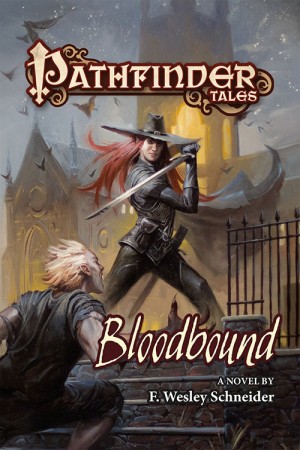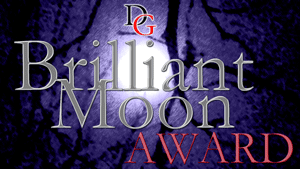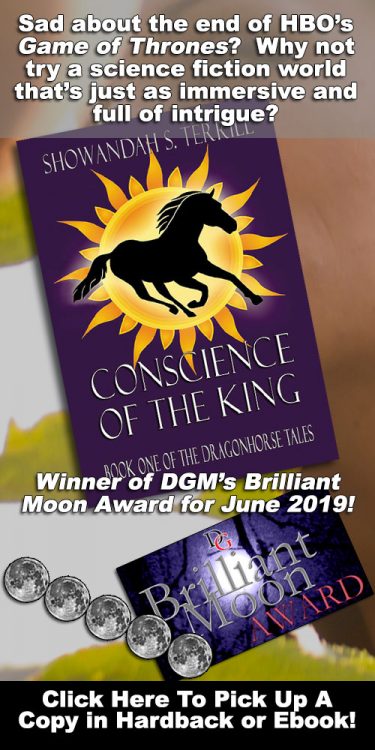 Author: F. Wesley Schneider
Author: F. Wesley Schneider
Publisher: TOR Books
Genre: Fantasy/Mystery
Unique Elements: Half-Vampire detective and mystic priestess seek to solve a sordid mystery
Series: Pathfinder Tales
Release Date: December 1st, 2015
Number of Page: 446 Pages
MSRP: $14.99 (print); $34.99 (Audio)
Discount Link: Click Here
Website: Click Here
Purchase: Print | Audio
Reviewed by: J.T. Hanke
Final Score: 5 Moons (out of 5)
Larsa is OFFICIALLY a Royal Accuser-the Pathfinder equivalent of the U.S. Marshalls meets the KGB-in the Ustalavian capital of Caliphas. Somewhat like the Marvel Knights’ character, Blade, she’s also half-Vampire/half-human (a half-breed known as a dhampir), which causes her to be held in contempt by both humans and vampires.

Despite Larsa’s pariah status, Siervage–the designated leader of the Vampires in Ustalav–has found a use for Larsa’s unique skills: vampire hunter. More like vampire dog catcher, she’s required to hunt down and destroying any rogue spawn who endanger the pact he’s made between the vampires and the humans in Caliphas.
Jadain is a young priestess of the Pharasma, the Goddess of Death and Life, who tends to be more willing to dwell on Pharasma’s mysteries than on labeling the heretics and hunting down the possessed. Her empathy soon brings her into conflict with the leader of her order’s Inquisitors who does everything in her power to destroy Jadain’s career and get her ex-communicated.
When a deadly vampire attack and a private possession lead both Jadain and Larsa to the same sanitarium, they find themselves thrust into a mystery of epic proportions that will force these protagonists to the “abandoned” capital of Ardis to face a Vampire lord, discover a lost mother, and uncover the demons they each represent to the other.
Story
The storyline of this book keeps you eagerly turning the pages, discovering new elements, twists, and connections. The characters are interesting enough that you want to know exactly what makes them tick and you root for them to get their vengeance on those who wronged them.
One thing that’s not often covered in story is the way in which the narrative-style is approached, because so rarely does it differ between a handful of historic styles, like “third person, past tense,” for example. However, sometimes authors choose very unique ways of telling stories, which break away from that group. Sometimes, this choice is a disastrously poor one, such as the bizarre third person, present tense of the recent Star Wars Aftermath, which bucked me out of the story at every step. And then, sometimes, a unique choice is perfect.
Good “First Person Narrative” is a joy to behold, as it has an immediacy to it that pulls a reader in-and it favors the sort of noir tales most often found in gritty detective (or vampire) tales. Unfortunately, there are some stories it just can’t tell, because you often need to show more information than a single viewpoint can handle. With that said, Schneider’s unique choice was actually something I’ve always wondered about: “dual” first-person narrators. And it works masterfully!
By using this “duet” form, subtitling each chapter with the character whose perspective is being described and keeping a strict alternating pattern between the characters, Schneider is able to tell a much more complex story than first person normally permits, while still keeping the nearness and “driven”-style of first person storytelling. (With that said, it’s clear that two is probably the limit for first-person narrators, because you have to take in so much more information about each person in first-person than you do in a third-person viewpoint system, such as the one George R.R. Martin uses in his Song of Ice & Fire series.)
One concern that I always have with a very stylized storytelling method is whether it’ll end up being style over substance. The MTV-flavored Tony Scott film, Domino, was style over substance all the way through, but for most tales the ending is the proving ground. The stylistic Neil Burger film, Limitless, was a masterpiece of a tragedy for 95% of the film, but then was completely destroyed by the wrong ending. I remember the first time I watched Chris Nolan’s mind-bending film, Memento, being concerned that there was no ending that could live up to the unexpected way they presented the story-and I was so glad to be proven wrong.
With more similarities to the last example, Bloodbound manages to connect the style and the substance throughout with a cathartic ending that just makes sense-and leaves you eager for a sequel. And perhaps a feature film. (Which, if they do make a film, hopefully they can get Orphan Black‘s Jordan Gavaris to play the vampire Considine, who I kept seeing in my mind’s eye! For the leads, perhaps Pauley Perrette as Jadain and Gwendoline Christie or Emily Blunt as Larsa.)
Dynamics
The dynamics of this novel are very cool in a number of ways. The interpersonal dynamics between the socially-insensitive dhampir investigator, Larsa, and the empathetic Gothic priestess, Jadain, are very positively reflective of those between Sherlock Holmes and Watson, while still having many unique nuances beyond the lack of a “Y” in the protagonists’ chromosomes.
One of the dynamic components of the storytelling itself that I really appreciated (which takes it a level above the aforementioned Holmes & Watson roles) was how Schneider explores the complexities of faith vs. religion, outcast vs. acceptance, and assumption vs. friendship in the role of his two protagonists. It’s not hard to see parallels between how different groups in our world tend to write off or demonize those who are different or are seen as anomalies. Undoubtedly, we’ve all been hurt by this type of behavior and judgementalism (and, unfortunately, likely passed on some of it to others, at times, ourselves), but I really loved that Schneider explored this in a very human, “walk a mile in one anothers’ shoes” sort of way. While there are still extremes on both ends of the spectrum shown throughout the book, the fact that there are so many shades to things make the book extremely engaging-especially when it might easily become monotonously dark with less subtlety.
Gothic Fit
Obviously, on the surface, when you’re starting out with a Gothic city, a death priestess with black lacquered nails in a mystic habit, a vampire-human halfbreed investigator/vampire-slayer, or a mystical old woman whose hiding a house full of secrets, you immediately assume that the story in question might be a good fit for a Gothic audience. However, when you take away all the Gothic trappings, you still have a very Gothic tales that explores the search for truth-no matter the cost-and which doesn’t shy away from the darkness in that pursuit.
Closing Thoughts
Bloodbound is an incredibly good investigative thriller that’s immediately accessible, even if you know nothing about the Pathfinder world (or if you’re looking for a great introduction to it from a Gothic perspective).
Although Schneider has had a major part to play in the writing and editing of the Pathfinder RPG series, this is his first solo novel. It would be a great book by an experienced novelist, but it’s even more incredible for a debut effort. I can’t wait to see what his next book is! (And for those of you who want to hear it on audio book, this one is narrated by the extremely talented Ilyana Kadushin.)
Story: 5.0 Moons (out of 5.0)
Dynamics: 5.0 Moons (out of 5.0)
Gothic Fit: 5.0 Moons (out of 5.0)
Final Score (not an average): 5.0 Moons (out of 5.0)
![]()

